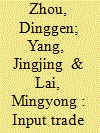|
|
|
Sort Order |
|
|
|
Items / Page
|
|
|
|
|
|
|
| Srl | Item |
| 1 |
ID:
169156


|
|
|
|
|
| Summary/Abstract |
In this paper, we examine the role of cultural factors in attracting international students using data of 102 countries and regions from 2000 to 2015. Our results show that the export of cultural products is conducive to the increase in international students. International students choose to study in developing countries with an official language and religious beliefs that are different from their home country, but tend to choose developed countries with a common language. We also analyze the features of inbound and outbound international students specific to China. Our study indicates that “soft power,” such as a unique culture, common values and migration networks, is important for attracting foreign students.
|
|
|
|
|
|
|
|
|
|
|
|
|
|
|
|
| 2 |
ID:
169158


|
|
|
|
|
| Summary/Abstract |
This paper summarizes global imbalance adjustment after the GFC and analyzes the evolution of balance of payments using a four‐quadrant diagram. We construct the framework of a stock adjustment mechanism to analyze the main driving factors for the imbalance in surplus/deficit countries and debtors/creditors in an attempt to determine the sustainability of imbalance adjustment. We find that imbalances have been reduced to some extent, but most countries have not achieved rebalance after the global financial crisis. Therefore, we propose an ideal path for global imbalance adjustment and summarize the policy practices of representative countries that have followed this route. Based on our analysis, we suggest that China should learn from the Australian experience and adopt a macro‐prudential assessment policy, actively adjust the domestic economic structure and optimize the structure of balance of payments.
|
|
|
|
|
|
|
|
|
|
|
|
|
|
|
|
| 3 |
ID:
169155


|
|
|
|
|
| Summary/Abstract |
This paper introduces a quasi‐natural experimental framework into trade policy evaluation and reassesses China's trade liberalization through the survival of export products. We use propensity score matching and China's dual trade system to design a quasi‐natural experiment based on Chinese industrial enterprises, customs import and export, and tariff data over the period of 2000–2006; we then use survival analysis to study the impacts of China's trade liberalization on the export duration of manufacturing firms’ products. We find that the substantial reduction in import tariffs after China's accession to the World Trade Organization enhances the export duration of firm products, indicating that trade liberalization ameliorates the survival of export products. The promotion effects of tariff reduction on export duration are obviously stronger for core products than for noncore products.
|
|
|
|
|
|
|
|
|
|
|
|
|
|
|
|
| 4 |
ID:
169157


|
|
|
|
|
| Summary/Abstract |
As rapid economic growth in China has led to significant appreciation of urban real estate market values, this study examines China's influence on Asian–Pacific real estate markets by focusing on their respective market integration with the US, Japan and China during the period January 2005 to December 2017. Market integration is examined by unconditional and time‐varying conditional correlations, nonlinear Granger causality and dynamic connectedness effects. Overall, although the US and Japanese real estate markets have significantly influenced return and volatility in the regional markets, China has emerged as another major regional real estate volatility leader with rising influence over volatility integration, especially during the 2007–2011 crisis period. Financial crises have strengthened China's volatility connectedness effects and market integration with other Asian–Pacific real estate markets. Our results imply that the benefits of regional portfolio diversification may be declining as volatility integration across the Chinese and Asian–Pacific real estate markets becomes stronger. Therefore, diversified global investors should pay greater attention to these real estate markets.
|
|
|
|
|
|
|
|
|
|
|
|
|
|
|
|
| 5 |
ID:
169159


|
|
|
|
|
| Summary/Abstract |
In recent years, as China has grappled with rising debt and broad economic restructure, the prevalence of zombie firms has become a critical problem. This paper provides a theoretical framework illustrating the rationale behind the occurrence of zombie firms from the perspective of banks. We develop differential equations to model a bank's expectation and the ex ante estimate that underlies its decision to refinance an insolvent borrower. An optimistic expectation is essential in zombie lending and is intrinsic to the countercyclical pattern of zombie firms. Our model also predicts that debt can build up to an unsustainable level if recovery of profitability is sluggish or the initial debt burden is too high. Examining the Chinese experience of zombie firms over 2007–2017, this paper highlights two findings. First, the share of zombie firms among Shanghai and Shenzhen A‐share listed companies demonstrates a countercyclical pattern. Second, the positive correlation between zombie share and debt accumulation across manufacturing sectors sheds light on the link between zombie firms and the rising corporate debt in China. To deal with the “zombie” problem, the government should carefully weigh its policies to avoid further distortions because the occurrence of zombie firms may be inevitable and impossible to eliminate.
|
|
|
|
|
|
|
|
|
|
|
|
|
|
|
|
|
|
|
|
|